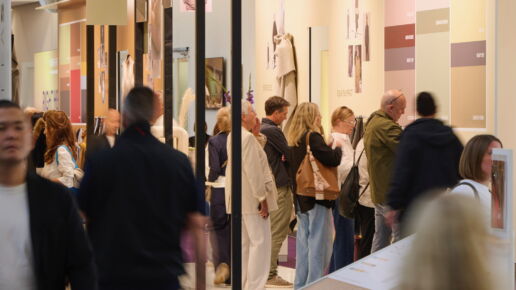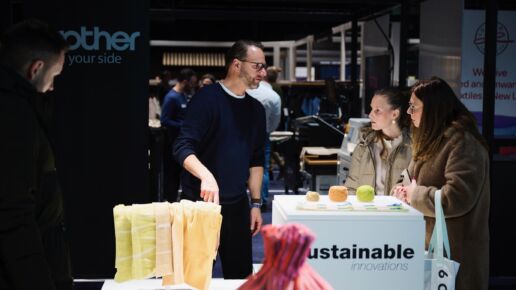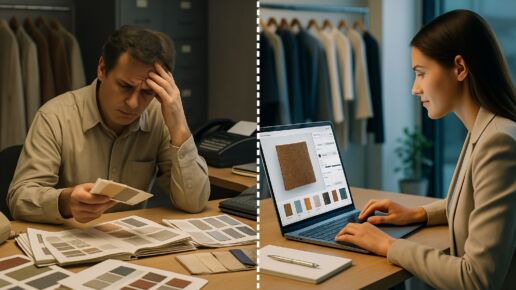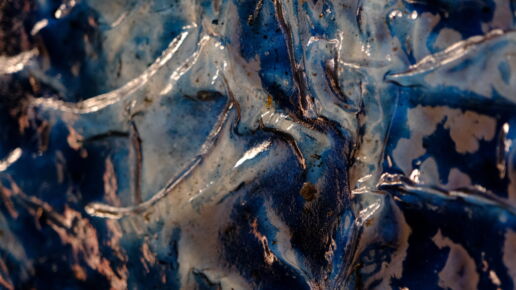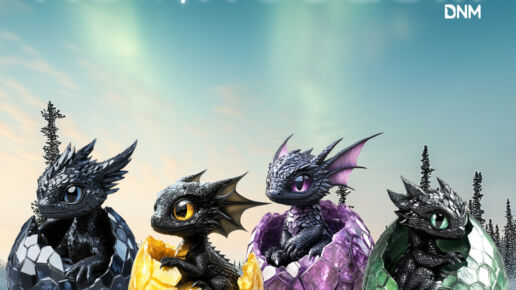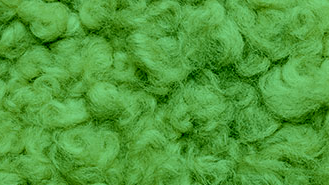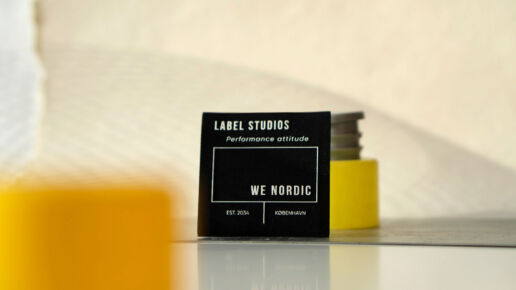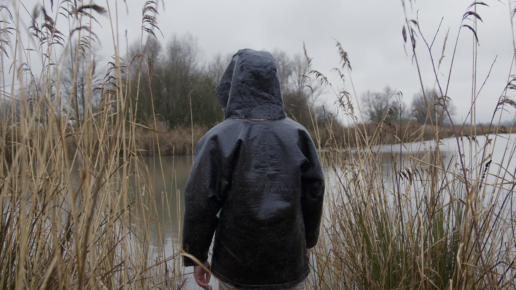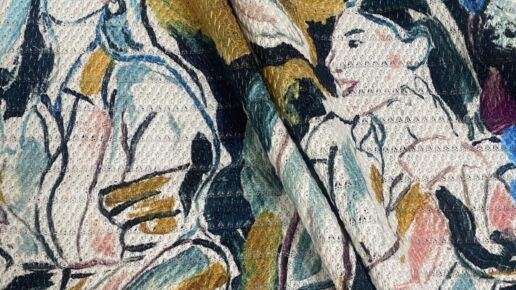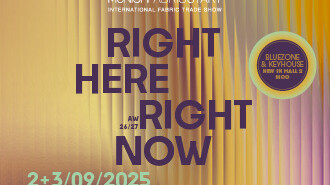Simon, this season’s Sustainable Innovations (SI) exhibit at Munich Fabric Start seems to have taken a more introspective turn. Could you share how you’ve approached the curation for this year?
Simon Angel: Absolutely. If you look at our past themes, they almost read like serialized literature. We began by exploring the challenges designers faced and the industry’s reluctance to move beyond traditional practices. Over time, our sustainable theme has woven itself into the very fabric of our industry—integrating into processes, policies, and people’s mindsets. This season, we’re continuing this saga by posing critical questions and embracing a more holistic narrative. It’s less about solutions and more about interventions and transformative thinking.
Interesting. Could you elaborate on how this philosophy manifests in the exhibited projects?
Simon Angel: Certainly. Take Suzanne Oude Hengel’s “Knit in Motion” as an example. Suzanne’s work challenges conventional knitting practices and pushes boundaries. Her exploration into combining knitting with thermoplastic polyurethane (TPU) and 3D printing isn’t just about creating new forms; it’s about questioning and redefining traditional manufacturing processes. This fusion of techniques not only rejuvenates product design but also opens up new vistas for the industry.
Joris de Groot’s work is also featured prominently. How does his approach fit into this narrative?
Simon Angel: Joris’s approach is quintessential to our theme of questioning and innovation. His “2000N Pressed Shoe” and “Recycled Raincoat” projects exemplify how traditional techniques can be reimagined for modern applications. By integrating industrial processes with sustainable practices, Joris turns waste into valuable products, thus challenging the very concept of material utility in fashion. His collaboration on the “Welded Loop” project further demonstrates how combining different techniques can lead to novel, sustainable solutions.
Tjeerd Veenhoven’s projects with mycelium are intriguing. How do they contribute to the broader narrative?
Simon Angel: Tjeerd‘s work with mycelium embodies a leap towards sustainable material innovation. His “Mycelium 2D Printing” explores the use of fungal materials to replace conventional plastics and dyes. This aligns perfectly with our theme of questioning and rethinking systems. Tjeerd’s projects aren’t just about creating sustainable alternatives; they represent a paradigm shift in how we perceive and utilize biological materials in fashion.
Iris Veentjer’s “RietGoed” project also stands out. What role does it play in this season’s exhibit?
Simon Angel: Iris’s “RietGoed” is a prime example of how material innovation can address environmental challenges. By developing high-quality textiles from reed fibers, she tackles issues like soil subsidence and CO2 emissions. Iris’s approach is a testament to how sustainable practices can be seamlessly integrated into textile production, promoting both ecological balance and economic viability.
Ilse Kremer’s “Fabulous Fungi” introduces a novel way to approach textile dyeing. How does it fit into the exhibit’s overarching theme?
Simon Angel: Ilse’s “Fabulous Fungi” project is a brilliant illustration of how we can rethink traditional processes. By utilizing fungi to produce dyes, Ilse addresses both environmental and health concerns associated with synthetic dyes. This project embodies our theme of exploring and implementing alternative solutions that are both innovative and sustainable.
Lastly, can you shed some light on the BIOTEXFUTURE initiatives and its relevance to this year’s theme?
Simon Angel: BIOTEXFUTURE is at the forefront of transitioning the textile industry to biobased materials. This initiative, which includes projects like TransitionLab and LightLining, aligns with our broader narrative of fostering systemic change. By focusing on biobased polymers and sustainable textiles, BIOTEXFUTURE is paving the way for a future where the textile industry can achieve true circularity and sustainability.
How do you see these innovations influencing the future of the textile industry?
Simon Angel: These innovations represent a profound shift in how we approach textile design and production. They challenge existing paradigms and offer new perspectives on sustainability. By fostering a culture of questioning and experimentation, we’re not just enhancing the industry’s practices but also inspiring a broader societal shift towards more sustainable and thoughtful consumption.
Simon, thank you for sharing these insights. It’s clear that this season’s SI exhibit is not just about showcasing new materials but about sparking a deeper conversation about the future of our industry.
Simon Angel: My pleasure. I invite everyone to engage with these projects and be a part of this evolving dialogue. It’s through such collective exploration that we’ll truly drive forward sustainable innovation.
We look forward to experiencing this season’s exhibit and seeing how these pioneering ideas will shape the future.
Simon Angel: Thank you. See you at the SUSTAINABLE INNOVATIONS – and don’t forget: you’ll find us at the Keyhouse in Hall 7 this season!
Discover more industry-changing innovations at our upcoming trade shows:
MUNICH FABRIC START – September 25 closing report
4. September 2025
At its 56th edition, MUNICH FABRIC START reinforced its clear positioning. Over two days, the Munich textile trade show brought the fashion industry together with its four show-in-show formats.
Materials as Agents of Change with Simon Angel
1. September 2025
Each season, the Sustainable Innovations forum brings together projects that provoke, inspire, and challenge assumptions. This year is no exception, with work ranging from bio-luxury couture to energy-generating textiles and regenerative materials grown from wetlands.
AUTUMN.WINTER 26/27 FABRIC HIGHLIGHTS & MATERIAL NOVELTIES – PART X
31. August 2025
For the first time in Germany, S2G XR (Style 2 Garment eXtended Reality) will present a live demo of its 3D textile configurator at booth A4.20 Not a teaser.
Living Matter: Bio-Luxury for Future Materials
31. August 2025
Indigo, a colour with a lot of history, is the main focus of this project. Denim has always meant strength and durability, and its roughness is linked to work and usefulness.
BLUEZONE NEWS FOR SEPTEMBER 2025 – PART VI
31. August 2025
At DNM Denim, the journey continues. Inspired by nature’s cycles and guided by Flow Theory, the company moves from Challenge to Focus, and now to Freedom—the phase where potential becomes power.
BIOTEXFUTURE: How to Make Textiles from Fossils
30. August 2025
The program is a group of businesses and universities working together to find scalable, bio-based alternatives.
Additionals Trends Autumn.Winter 26/27 – Part 8
30. August 2025
This collection embodies softness, simplicity, and flow – from soft-touch labels and stretchable materials that move with the body, to a calming palette of pastel tones and organic, natural fibers.
Wetlands Matters – by Marc Wijkmans
29. August 2025
Wijkman’s idea came from a simple but important observation: animals carry seeds across ecosystems in their fur.
AUTUMN.WINTER 26/27 FABRIC HIGHLIGHTS & MATERIAL NOVELTIES – PART IX
29. August 2025
The designs embrace various trend themes – sometimes subtle, sometimes expressive – and lend each fabric its own distinctive character.
MUNICH FABRIC START September 2025 – Outlook
29. August 2025
The countdown is on: in just three weeks, Munich will once againbecome the epicentre of the European fashion and textile industry. During the first week ofSeptember, MUNICH FABRIC START Exhibitions GmbH will unite all key fashion segments underone roof, reaffirming its position as one of Europe’s leading textile trade shows.










